Understanding Lease Laws in the UK: A Comprehensive Guide for Property Practitioners
As a property practitioner, it is crucial to have a thorough understanding of lease laws in the UK. Leases are a fundamental aspect of property law and are often the backbone of real estate transactions.
In this comprehensive guide, we will delve into the various aspects of lease laws in the UK, providing you with the knowledge and insights necessary to navigate this complex area of law. Whether you are a solicitor, a property investor, or a landlord, this guide will equip you with the essential information you need to effectively advise your clients and protect their interests.
1. What is a Lease?
Let’s start with the basics. A lease is a contractual agreement between a landlord (the lessor) and a tenant (the lessee) that grants the tenant the right to occupy and use a property for a specific period of time in exchange for rent. The lease sets out the rights and responsibilities of both parties and serves as a legal protection for both landlord and tenant.
2. Types of Leases
There are different types of leases in the UK, each with its own characteristics and legal implications. Some common types of leases include:
– Fixed-term leases: These leases have a defined start and end date, providing both parties with certainty about the duration of the tenancy.
– Periodic tenancies: These leases have no fixed end date and continue until either party gives notice to terminate.
– Assured Shorthold Tenancies (ASTs): ASTs are the most common type of residential tenancies in the UK and offer certain legal protections for tenants.
– Commercial leases: Commercial leases are agreements for the rental of commercial properties, such as offices, shops, or industrial units.
3. Essential Elements of a Lease
A lease must include certain essential elements to be considered valid and enforceable. These elements include:
– Parties involved: The lease must clearly identify the landlord and the tenant.
– Property description: The lease should include a detailed description of the rented property, including its address and any specific features or limitations.
– Rent and payment terms: The lease must outline the agreed-upon rent amount, payment frequency, and any additional charges or fees.
– Duration: The lease should specify the start and end dates of the tenancy or indicate if it is a periodic tenancy.
– Rights and responsibilities: The lease should outline the rights and responsibilities of both the landlord and the tenant, including maintenance obligations, repair responsibilities, and use restrictions.
4. Rent Increase and Review
Rent increases and reviews are a common area of contention between landlords and tenants. UK lease laws provide guidance on rent increases and reviews to strike a fair balance between the interests of both parties.
It is important to note that rent increases are subject to certain legal constraints, and landlords must adhere to strict procedures in order to enforce a rent increase. Failure to comply with these procedures can render the rent increase invalid and unenforceable.
5. Repairs and Maintenance
Under UK lease laws, landlords have a legal obligation to maintain the property in a good state of repair and ensure that it complies with all relevant safety regulations. Tenants are also typically responsible for maintaining the property and reporting any necessary repairs promptly.
The lease should clearly specify the repair responsibilities of both parties to avoid any disputes or misunderstandings. It is advisable for landlords to conduct regular property inspections and keep records to demonstrate their compliance with their repair obligations.
6. Termination of a Lease
Leases can be terminated in various ways, depending on the circumstances and the type of lease. Some common methods of lease termination include:
– Expiration: A fixed-term lease automatically terminates upon reaching its end date without the need for notice.
– Notice: For periodic tenancies, either the landlord or the tenant must serve a valid notice to terminate the tenancy.
– Break clauses: Some leases may include break clauses that allow either party to terminate the lease earlier than the agreed-upon end date.
It is crucial to follow the proper legal procedures when terminating a lease to avoid legal complications or claims for wrongful eviction.
7. Lease Renewal and Extension
Lease renewal and extension are important considerations for both landlords and tenants. UK lease laws offer certain protections to tenants, allowing them to either renew their tenancy or apply for a lease extension.
Landlords should be aware of the statutory procedures and timelines involved in lease renewals and extensions to ensure compliance with the law and maintain a good landlord-tenant relationship.
Conclusion
Having a comprehensive understanding of lease laws in the UK is essential for property practitioners. From the types of leases to the termination and renewal processes, navigating this complex area of law requires a firm grasp of the legal principles and practical considerations involved.
By familiarizing yourself with the information provided in this guide, you will be better equipped to advise your clients, protect their interests, and ensure compliance with lease laws in the UK. Remember, keeping up with the latest developments in property law is crucial to staying ahead in this ever-evolving field.
For more insights on related legal topics, we invite you to explore our articles on:
– Understanding Contractual Capacity: Rights and Limitations
– Interactive SQE Mock Tests for Contract Law: Test Your Knowledge
– Join Our SQE Contract Law Webinars: Expert Insights and Guidance
– Contract Law Reforms: An Analysis of Recent Changes
– Parties in a Contract: Rights and Responsibilities
At SQE Property Law & Land Law, we are committed to providing expert legal insights and guidance to property practitioners like you. Stay tuned for more informative content to help you navigate the complex world of property law in the UK.
